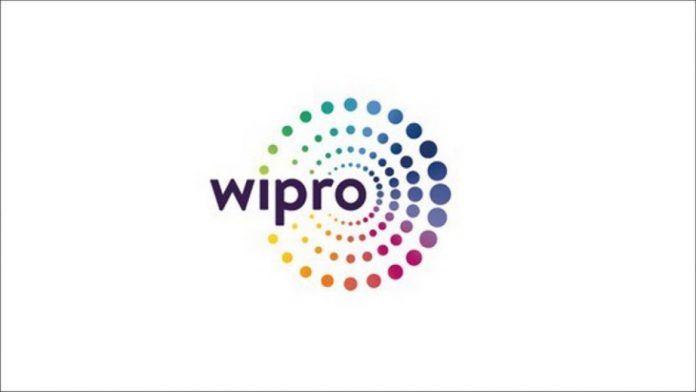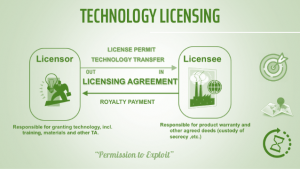This article is written by Shreya Mazumdar pursuing Diploma in Cyber Law, FinTech Regulations, and Technology Contracts from LawSikho.
Table of Contents
Introduction
Technology licensing agreement is the kind of agreement that is drafted for the transfer of intellectual property (IP) from one entity to another and is the mode to collective means of transferring where the licensee shall attain a right to use the technology for a particular fee for a fixed period. One can draw parity of technology license agreement to something similar to the rental agreement. In the case of a rental agreement, the landowner gives its tenant permission to occupy and use the land/apartment for a period of time in consideration of rent. When it comes to technology license agreements the owner of the IP gives the other party the use of a certain IP for consideration of payment known as “royalties” or “license fees”. In the case of the technology license agreement, only some permission regarding the IP is granted to the third party. The two terms that are used for the owner of the IP and the other party who possesses it are “licensor” and “licensee”, respectively. For a clearer understanding following pictorial representation can be referred to.
Wipro Limited is India’s one of the leading global information technology, business process, consulting, and service companies. Wipro deals with technology including cognitive computing, robotics, hyper-automation, and other emerging technologies that the world can witness.
This article provides an insight into how Wipro drafts its technology licensing agreements as one can understand that these kinds of agreements are the very essence of business deals of the company. Let us assume a situation where Wipro Limited has a cloud computing mechanism and this mechanism has achieved a new level of innovation. It has become very famous for its secure and easy storage system and now Wipro wants to test out the market in the United States and wants to launch this with its business partner Cisco, USA. They want to draft out a technology licensing agreement to transfer this technology of cloud computing mechanism. Let us dive into how these parties can draft this agreement to protect their interests.
Negotiation between Wipro and Cisco
Before this technology license agreement starts there is a negotiation session where the parties, Wipro and Cisco get together and ask themselves a series of questions. But before all of that, they may enter into a non-disclosure agreement so that confidentiality is protected. After this, it begins with establishing the position of each party, that is, which party is the licensor (Wipro) (the party who has the ownership of the IP and gives the license) and which party is the licensee (Cisco) (the party who wants to use the IP and wants to receive the license). It can start with the reason for this business license. Some of the questions include:
- What is the monetary distribution between the parties relating to this technology licensing agreements?
- What is the gain that each party accomplishes for the agreement to reach its value?
- What are the best results that each party can obtain?
- What is the objective of each party? What does each party obtain?
- What are the technical standards or specifications that the licensee needs to comply with?
The above mentioned are just a few questions on which both the licensor and the licensee ponder upon and then they create a term sheet based on this discussion.
Once the parties step into the drafting stage following paragraphs describe the clauses that can be looked into.
Scope and subject matter
The scope and the subject matter of the agreement shall be vividly defined. In this scenario, it includes the technology of the cloud computing mechanism that is transferred from the licensor to the licensee. It is very essential to detail out certain restrictions such as technology uses, geography-based limitations, property uses, sublicensing, etc.
Exclusive or nonexclusive
The very fundamental aspect of a technology license agreement is if the license that is granted will be exclusive or nonexclusive. In the case of exclusive only Cisco will use this license where Cisco does not have to worry about the fact that Wipro will subsequently make the technology available to others. Although in this case the royalty/fee that Cisco may have to pay to Wipro will be higher than the fee/royalty paid in connection to the nonexclusive license. In some cases, minimum thresholds called ‘milestones’ are drafted in the agreement which typically ties a minimum payment that has to be paid by the licensee to maintain the exclusivity of the agreement.
Patent, trade secrets and know-how
The patents, trade secrets, and know-how have to be mentioned in the license agreement if Wipro is permitting Cisco to practice and commercialize IP owned by Wipro. Wipro has to give this affirmation that Cisco shall have the license to use the patent, trade secrets and know-how.
Wipro being the licensor can give away or transfer his interest in a patent to Cisco, the licensee. These rights on this invented cloud computing mechanism that has patent, trade secret, and know-how owned by Wipro can be given away for a period of time over the mutual agreement. During this period of the license, Cisco can make use of this patent, trade secret, and know-how that can extract benefit and have rights on the interest on them.
Prevalent technology license agreement provisions
1. License grant
This provision lists down the license that will be granted to Cisco under this technology license agreement. Furthermore, the agreement will specifically define the rights that Cisco will have concerning the intellectual property of the technology under this agreement. It can be drafted as follows:
- Wipro shall take the following actions to provide Cisco with all information and data necessary or useful to enable Cisco to practice Wipro’s Patent Rights and Wipro’s intellectual property for purposes of making, having made, using, have used, offering for sale, selling, having sold and importing Licensed Technology.
- Schedule for technology transfer
- Wipro shall take the following action to provide Cisco or its designees with all information that is necessary or useful to enable Cisco and its designees to engineer the Licensed Technologies conforming with applicable specification (and any enhancements, modifications, upgrades, corrections, and components to the Licensed Technologies developed during the term of this agreement), including any drawings, manufacturing instructions, testing equipment vendors (and detailed modification notes for any modifications made to such testing equipment for purposes of testing the products), equipment settings, costed bills of materials, testing procedures, or other information as well as any manuals, programmers notes, and other materials needed to access and use such materials.
- Wipro will provide all know-how and instructions, including knowledge, documentation, contacts, and support necessary to enable successful engineering of Licensed Technologies.
- Wipro’s employees or agents will be available, on a reasonable basis (at no further cost to Cisco), for questions and trouble-shooting support to affect the successful transfer of the technology.
The license grant for technology uses some terminologies for this licensing which includes:
- Make: In this case, the licensee has licensed the right to make the technology which the licensor has its patent.
- Have made: The licensee can engineer other products from the patent rights for the Licensee technology.
- Import: The licensee is permitted to import the product/technology that is covered by the licensed patent claim.
- Use: The licensee can make use of the technology that is covered by the licensed patent claims.
- Have used: In this case, the licensee is given the rights where they can allow others to practice the technology that is covered by the licensed patent claims. This is not a license.
- Offer for sale and sell: The licensee can offer for sale and sell technology that is licensed patent claims.
- Have Sold: The licensee can have any other third party sell the technology that the licensed patent claim covers.
It is very crucial to note the difference between these patent grants so that while reviewing or negotiating the agreement one can note down the above actions that are omitted from the license grant.
2. Contract terms or renewal opportunities
The agreement that is to be entered into should mention the date on which the licensee can start using the technology and it should also mention the term of use for the agreement. The agreement will be incomplete if it does not mention the renewal or extension period. The agreement should point out the methods for the licensee to advise Wipro of the intent to agree or disagree for a renewal. This can clarify a lot of confusions that might be brought in at a later point in time.
3. Representation and warranties
This clause is one of the common clauses in most agreements. These are the specific promises made by the parties in an agreement. Representation means a collection of facts or a set of facts in a manner to persuade someone either by words or by action to enter into a contract. Whereas warranty is a set of provisions which is a promise to the other party mentioning the quality of goods or services that will be provided as a consequence of the agreement. In the representations clause, the appropriate standard of liability shall be properly expressed. If it is from the side of the party who is making the representation then the number of representations should be minimum and precise, maintaining any potential liability. If this representation is from both the side of the party then, in that case, the clause should be broad and loose ended so that it is easier to bring a claim of representation.
This clause can be drafted as:
- Each party hereby represents and warrants to the other that:
- It has all requisite power and authority to execute, deliver and perform this agreement and to consummate the transactions contemplated hereby;
- This agreement has been duly authorized, executed and delivered by such party, constitutes the legal, valid and binding obligation of such party and is enforceable against such party in accordance with its terms;
- It shall not disclose to the other party any proprietary confidential information of any third party.
- Additional representations of Wipro
- Wipro has no knowledge that any issued patents that are part of licensor patent rights are invalid or unenforceable.
- Wipro has no knowledge of any claims, judgments, or settlements against Wipro pending, or threatened, that invalidate or seek to invalidate the Wipro’s Patent Rights. Wipro has no knowledge of any pending litigation against Wipro or any Affiliate of Wipro or any licensor of Wipro that alleges that any of Wipro’s activities have violated or Licensed Products would violate, any of the intellectual property rights of any third party (nor has it received any written communication threatening such litigation).
- Wipro has not previously assigned, transferred, conveyed, or otherwise encumbered its right, title, and interest in the licensor patent rights or the licensor intellectual property in a manner inconsistent with the terms hereof.
- Wipro is the sole and exclusive owner of its patent rights and its intellectual property and no other person has any claim of ownership with respect to such Wipro’s Patent Rights and Wipro’s Intellectual Property.
- Wipro has obtained the assignment of all interests and all rights of any and all third parties (including employees) involved in the creation of its patent rights and intellectual property.
- Wipro has no knowledge of any use, infringement, or misappropriation of Wipro’s Patent Rights or Wipro’s Intellectual Property in derogation of the rights granted to Cisco in this agreement.
4. Confidentiality
Of course, confidentiality is one of the most important provisions of a technology licensing agreement. Wipro has to safeguard the technology and its know-how, patent, and trade secrets, and therefore in order to keep this confidential Cisco has to maintain the same confidentiality. There are two basic clauses for confidentiality, the first one is that the receiving party shall not disclose this confidential information to the third party and secondly, the receiving party will not use the confidential information for any other purpose other than the obligation under the agreement. This clause is included to protect confidential information that can be used which violates the agreement and it could potentially “infect” the separate technologies with the intellectual property that is received under other license agreements.
5. Indemnity
Under the technology license agreement Wipro, the licensor has to defend and indemnify Cisco, the licensee in case there is a third-party claim for the license technology infringement. These lawsuits can run into millions of dollars so the limitation of liability clause is also important in these situations.
This clause to defend and the duty to indemnify should be included in the license agreement in order to protect Cisco. The absence of this clause leaves Cisco fully exposed to unwanted liabilities. Also, to protect Wipro, a limitation of liability clause can be drafted in order to provide a limit to the amount Wipro has to pay if the losses are suffered. This will prevent Wipro to be liable for an exorbitant and unforeseeable amount of indemnity liability.
6. Term sheet
A term sheet is a blueprint used by the parties to outline and agree upon the high-level aspect of the license agreement prior to the negotiation of the details of the license agreement. This is an organised process for those who help both the parties to determine at very early on whether there is disagreement over the fundamental aspect of the deal. This process streamlines the preparation and negotiation process of the detailed license agreement because the parties in the process of this have to agree to the fundamental aspect of the deal before getting into the details of the agreement itself. A term sheet is not binding unless it is expressly mentioned that a few of the clauses like confidentiality or non-disclosure can be binding.
Conclusion
A technology licensing agreement is not a cut-copy of an agreement and it cannot be a “one size fits all” technology license agreement and the parties must make sure that the license agreement is custom-made as per their requirements. It should be ascertained that the business needs of both sides are met. In order to provide more clarity on the points that could be negotiated upon a format of the term sheet is added which is as follows.
|
Term sheet format for technology license agreement 1. Parties Identify the parties involved in the business deal. 2. Term and renewal Identify the essential date and if the agreement can be renewed 3. Scope of the matter Identify the patents, patent application, trade secrets, know-hows, etc. Provide the description of the technology which includes but does not limit to: U.S. Patent No: U.S. Patent Application No.: Other IP or know-how: 4. Ownership Who owns the license technology? 5. Royalty/charges What are the charges? Is it a milestone payment or a one-time payment? 6. Related agreements State the other agreements existing with any other parties which may include the confidentiality agreements. 7. Development This part explains the stage the technology is in if it is entirely developed or partially complete. 8. Scope of the license Identify the exclusivity and non-exclusivity of all the technologies that are transferred. This has to be identified for the IP, know-how, and all the trade secrets. 9. Improvements and derivative works Ownerships of improvements to the Licensed Technologies shall lie with which party. 10. Sub-licensing Identify if the licensee can sub-license 11. Limitation of liability Shall be identified as to the amount that licensor will be liable for in case of indemnity. 12. Obligation of the parties This should be listed out as to what is expected out of each party. |
References
- https://blog.ipleaders.in/technology-transfer-agreement-v-licensing-agreement-major-differences/
- https://www.slideshare.net/FranzNicholeSalomon/anatomy-of-technology-licensing-agreements
Students of Lawsikho courses regularly produce writing assignments and work on practical exercises as a part of their coursework and develop themselves in real-life practical skills.
LawSikho has created a telegram group for exchanging legal knowledge, referrals, and various opportunities. You can click on this link and join:
 Serato DJ Crack 2025Serato DJ PRO Crack
Serato DJ Crack 2025Serato DJ PRO Crack












 Allow notifications
Allow notifications



